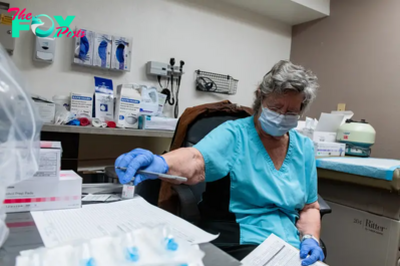Health
The $1.3 billion-plus problem: Explaining medical debt in Colorado
Picture a room with 100 people in it — just regular adults, people with jobs and monthly bills and credit scores.
In America, if that room contains a sufficient cross section of the population, as many as 40 people will have debt stemming from medical or dental care, according to one national survey. Two out of every five.
☀️ READ MORE

UCHealth sues thousands of patients every year. But you won’t find its name on the lawsuits.
Read moreNow zoom in and apply that to Colorado, which national data suggests is fairly average when it comes to the number of people with medical debt. That’s potentially well over 1 million adults in the state with outstanding Health care bills or medical debt. It’s a population that if it were its own city would be the state’s largest by far.
Medical debt is the most common collection item on consumer credit reports nationally, according to the Consumer Financial Protection Bureau. But it also lurks in other ways — as credit card bills and payment plans and loans needing to be repaid to friends or family.
In Colorado, as in other states, that makes it a shark in people’s economic oceans, gliding stealthily beneath the surface, invisibly stalking until it isn’t. When it attacks, it often bites deep.
“Medical debt impacts Coloradans profoundly,” the state Attorney General’s Office wrote in a brief last year on medical debt. “It can damage or ruin credit records, destroy families’ financial stability, deter seeking needed medical treatment, or lead to bankruptcy.”
Because no organization or government agency tracks medical debt in total, it can be difficult to gauge the scale of the problem. But here are seven charts that help get a handle on medical debt in Colorado and how it compares to the problem in other states.
Total medical debt burden is huge
The easiest way to track data on medical debt is by looking at credit reports.
But medical debt doesn’t just live on credit reports. It can also take the form of credit card debt, if people use a credit card to pay off a health care bill. Same if they take out a loan from a bank or family member. It also might exist as a payment plan directly with a medical provider or even a bill constantly being haggled over.
The nonprofit Colorado Health Institute polls Coloradans every other year on issues around health care access and affordability. One of the questions it has previously asked participants is whether they struggled with medical bills in the past year and, if so, how they paid them off.
In 2021, when it last asked this question, 11.3% of people said they had trouble paying a medical bill. Of those, 53.8% said they took on credit card debt to pay it and 17% of people said they took out a loan.
The U.S. Census Bureau every year tries to answer the question of total medical debt burden in the United States. In its most recent data, from 2021, the bureau estimated that 15% of U.S. households are holding medical debt, with the median amount around $2,000.
KFF, a nonprofit health policy foundation that was formerly known as the Kaiser Family Foundation, has undertaken perhaps the most ambitious effort to understand the true scope of medical debt in America.
In 2022, it conducted a poll that asked respondents about “any money they currently owe or debt they have due to medical or dental bills for their own medical or dental care or someone else’s care, such as a child, spouse, or parent.” Debts could include not only unpaid bills on credit reports, but also those being paid off through installment plans, credit cards, or other loans.
KFF found that 41% of adults in the U.S. — approximately 100 million people — have some kind of medical debt.
☀️ READ MORE
Colorado physicians must improve by prioritizing “culturally responsive care,” new report says
Colorado business leaders are neutral about the economy — the best they’ve felt in two years
Small Colorado mill wins competitive $22M federal grant to decarbonize, use less water
$1.3 billion in collections
More specific Colorado-level numbers are available by looking at credit data, which measures a subset of medical debt that ends up on people’s credit reports.
In a 2022 report, the Consumer Financial Protection Bureau estimated that people in Colorado had more than $1.3 billion worth of medical debt in their credit files. In that report, which used data from late 2020, the CFPB estimated that 12.2% of Coloradans had medical debt in their consumer credit file.
Using more recent data, from 2022, the nonprofit Urban Institute last year estimated that just shy of 11% of Colorado adults have medical debt on credit reports, a higher percentage than those who are in default on student loans or delinquent in paying credit cards or auto loans.
That puts Colorado just below the national average. In the Urban Institute’s analysis, West Virginia had the highest percentage of people with medical debt in collections — nearly 24% — while Minnesota had the lowest, with 2.4%.
-

 Health20h ago
Health20h agoTeens Are Stuck on Their Screens. Here’s How to Protect Them
-

 Health1d ago
Health1d agoHow Pulmonary Rehab Can Help Improve Asthma Symptoms
-

 Health1d ago
Health1d ago10 Things to Say When Someone Asks Why You’re Still Single
-

 Health2d ago
Health2d agoThe Surprising Benefits of Talking Out Loud to Yourself
-

 Health2d ago
Health2d agoDoctor’s bills often come with sticker shock for patients − but health insurance could be reinvented to provide costs upfront
-

 Health2d ago
Health2d agoWhat an HPV Diagnosis Really Means
-

 Health3d ago
Health3d agoThere’s an E. Coli Outbreak in Organic Carrots
-

 Health4d ago
Health4d agoCOVID-19’s Surprising Effect on Cancer


























